Building your own geothermal heat pump can drastically cut your energy bills while boosting efficiency. Start by choosing the right system type—horizontal loops are often easier for DIY projects. You'll need to calculate your home's heat loss to size the heat pump correctly. Excavate trenches 4-6 feet deep for the loops, and construct a DIY manifold using PVC fittings. Don't forget ductwork considerations to guarantee ideal airflow. Finally, remember to check for local regulations and available tax credits that can save you money upfront. With this guide, you're on your way to mastering your energy solution.
Geothermal Heat Pump Basics
Geothermal heat pumps are an innovative solution that harnesses the earth's stable underground temperature, typically hovering around 50-55°F, to provide efficient heating and cooling. Unlike traditional air-source systems, these pumps excel in colder climates, making them a smart choice for your home.
By utilizing a closed loop system, geothermal heat pumps circulate a water/antifreeze mix through buried pipes. This process absorbs heat from the ground in winter and dissipates it back into the earth during summer, ensuring your home stays comfortable year-round. Additionally, implementing budgeting tools can help homeowners assess the financial impact of installing these systems. Moreover, these systems often qualify for incentives and rebates, making them even more appealing for prospective buyers.
One of the standout features of geothermal heat pumps is their impressive Coefficient of Performance (COP), which ranges from 3.5 to 5. This means they can generate 3.5 to 5 times more heat per kilowatt-hour than electric heaters, showcasing their efficiency.
Furthermore, modern geothermal systems adapt well to various climates, providing flexibility for homeowners everywhere. Monitoring savings and investments can help homeowners budget for the initial installation costs and maximize their long-term savings.
Installing a geothermal heat pump can lead to significant cost savings on energy bills. The U.S. EPA reports reductions in heating costs by 30-70% and cooling costs by 20-50%, making this an investment worth considering for long-term comfort and savings.
Benefits of Geothermal Systems
One of the biggest advantages of geothermal systems is their ability to greatly lower energy bills. By reducing heating costs by 30-70% and cooling costs by 20-50%, these systems are among the most cost-effective options for home energy use.
With a Coefficient of Performance (COP) rating between 3.5 and 5, geothermal heat pumps generate considerably more energy than they consume, making them efficient for both heating and cooling. Furthermore, implementing automated payment solutions can streamline your budgeting process, allowing you to manage energy savings more effectively. Budget apps provide tools that can help track these savings over time.
Another key benefit is the longevity of geothermal systems. Indoor components can last up to 25 years, while ground loops may last 50 years or more, leading to lower long-term replacement costs.
Plus, these systems operate quietly, enhancing your indoor comfort without the disruptive noise often associated with traditional heating methods.
You might also find financial relief through federal incentives. Homeowners may qualify for a 30% federal tax credit for geothermal installation, which can considerably reduce your upfront investment and enhance the overall financial benefits over time. Additionally, implementing clear payment terms can help manage any associated costs more effectively.
Energy Source Explained
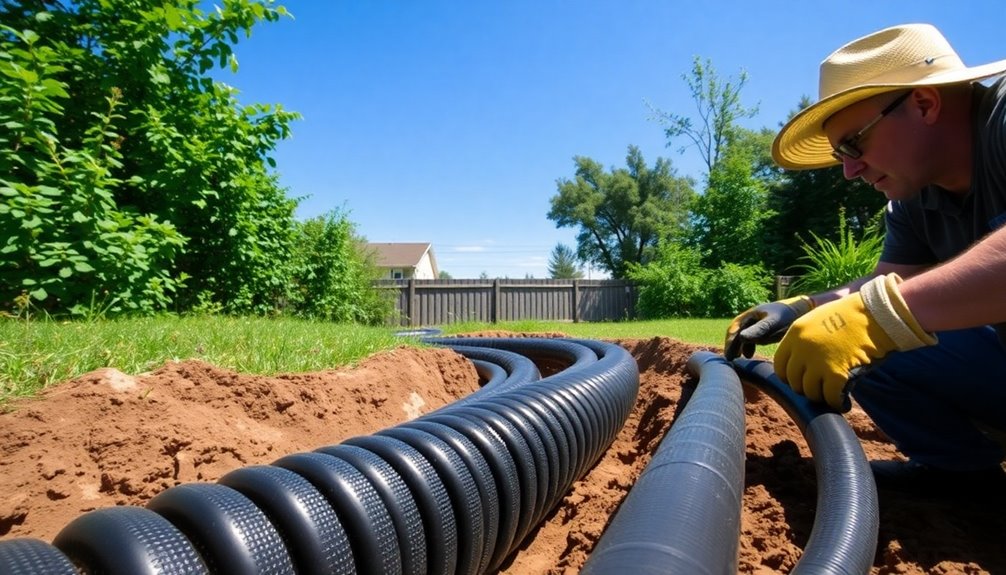
Geothermal heat pumps tap into the solar energy stored in the earth, taking advantage of the consistent ground temperatures that hover around 50-55°F. This stable temperature allows your system to efficiently heat and cool your home year-round, regardless of the weather outside. Additionally, utilizing sustainable materials in the installation of geothermal systems can further enhance the eco-friendliness of your energy solutions. By selecting ethically transparent retailers, you can ensure that the materials used for your geothermal system are sourced responsibly, contributing to a more sustainable energy solution. Furthermore, choosing systems that prioritize fair labor practices can help support the ethical production of components used in your geothermal installation.
Solar Energy Harvesting
Solar energy harvesting is often a misunderstood concept, but it's fundamentally about capturing the sun's energy to power various applications.
In the context of a geothermal heat pump, this process plays an essential role. While geothermal systems primarily rely on the Earth's stable temperature, they also take advantage of the solar energy absorbed by the ground. During sunny days, the sun warms the surface, allowing the ground to retain heat, which your geothermal heat pump can efficiently use.
Closed loop systems circulate a mixture of water and antifreeze through buried pipes. These systems absorb heat from the warmer ground and transfer it into your home.
With a Coefficient of Performance (COP) of 4 or greater, they can produce up to five times more heat per kWh than traditional electric heaters. This efficiency means you're not just harvesting energy; you're maximizing its potential while minimizing reliance on fossil fuels.
Earth's Stable Temperature
Harnessing the sun's energy is just one part of the equation when it comes to heating and cooling your home. Below the surface, the Earth maintains a stable temperature, typically ranging from 50°F to 55°F. This reliable energy source is perfect for ground-source heat pumps, allowing them to efficiently transfer heat into your home during winter and draw it away in summer.
With ground loops installed, these systems can produce 3.5 to 5 times more energy than they consume. This efficiency stems from the Earth's consistent temperature, which gives geothermal systems an edge over traditional air-source heating, especially in colder climates.
Even when the outside temperature drops, ground-source heat pumps excel, as they tap into the warmth stored underground.
Types of Geothermal Systems
When considering geothermal systems, you'll find three main types: horizontal ground loops, vertical ground loops, and water source heat pumps.
Each system has its own advantages depending on your property's layout and available resources. Utilizing expense tracking tools can help you budget for the costs involved in your DIY geothermal project. Additionally, integrating detailed insights from expense tracking apps can aid in managing the financial aspects of your geothermal installation effectively.
Understanding these options will help you choose the best fit for your DIY geothermal project. Many homeowners find that utilizing advanced technology in their systems can significantly enhance efficiency and performance.
Horizontal Ground Loop Systems
Utilizing horizontal ground loop systems can be one of the most straightforward ways to tap into geothermal energy for heating and cooling your home.
These systems are easier to install than others, as they use trenches dug 4-6 feet deep to bury the piping. If you have enough land, you'll find that horizontal ground loops are often the best choice for your ground-source heat pumps.
Here are a few benefits of horizontal ground loop systems:
- Simplicity: Installing these systems is relatively straightforward, making them ideal for DIY enthusiasts.
- Flexibility: You can use a slinky loop design to minimize trench lengths, allowing for efficient installation even in tighter spaces.
- Cost-Effectiveness: While you might need to rent heavy construction equipment for trench digging, the overall installation can be more affordable with proper planning.
Keep in mind that the effectiveness of horizontal ground loops depends on soil type, moisture content, and local climate.
As a result, conducting a site evaluation is essential to guarantee peak performance for your geothermal system.
With careful preparation, you can enjoy the benefits of efficient heating and cooling in your home.
Vertical Ground Loop Systems
For homeowners facing space constraints, vertical ground loop systems offer an efficient solution for geothermal heating and cooling. These systems use a closed loop of piping buried vertically, circulating a water/antifreeze mixture to absorb heat from the ground in winter and release it in summer.
Unlike horizontal systems, vertical loops require deep boreholes, making installation more expensive due to the professional drilling involved.
When sizing your vertical ground loop, remember the standard rule of thumb: you need about 150 to 200 feet of bore per ton of heating capacity. So, for a 3-ton system, you'll need around 600 feet of bore depth. This might sound intimidating, but don't let it deter you; the efficiency of vertical ground loop systems is impressive.
With coefficient of performance (COP) ratings exceeding 5, these systems can produce five times the energy they consume, particularly in colder climates where ground temperatures remain stable below the surface.
Though initial costs are higher, the long-term savings on energy bills and the superior efficiency of ground-source heat pumps often make this investment worthwhile.
Water Source Heat Pumps
Water source heat pumps are an excellent choice for homeowners looking to harness natural resources for efficient heating and cooling. By utilizing bodies of water like lakes or wells, these systems exchange heat, ensuring ideal performance year-round. A consistent water temperature of around 50-55°F is essential for effective heat transfer.
Here are some advantages of water source heat pumps:
- Energy Efficiency: These geothermal systems often outperform air-source systems, leading to lower operational costs.
- Consistent Performance: With stable water temperatures, you can expect reliable heating and cooling throughout the seasons.
- Reduced Environmental Impact: By using a natural resource, you're contributing to greener energy solutions.
When considering a water source heat pump, keep in mind that sizing is important. You'll need about 2-3 gallons per minute (GPM) per ton of cooling capacity to achieve the best results.
If you live in an area with sufficient water availability, this geothermal system can greatly enhance your home's energy efficiency. Overall, water source heat pumps offer a practical and eco-friendly solution for modern heating and cooling needs.
Sizing Your Heat Pump
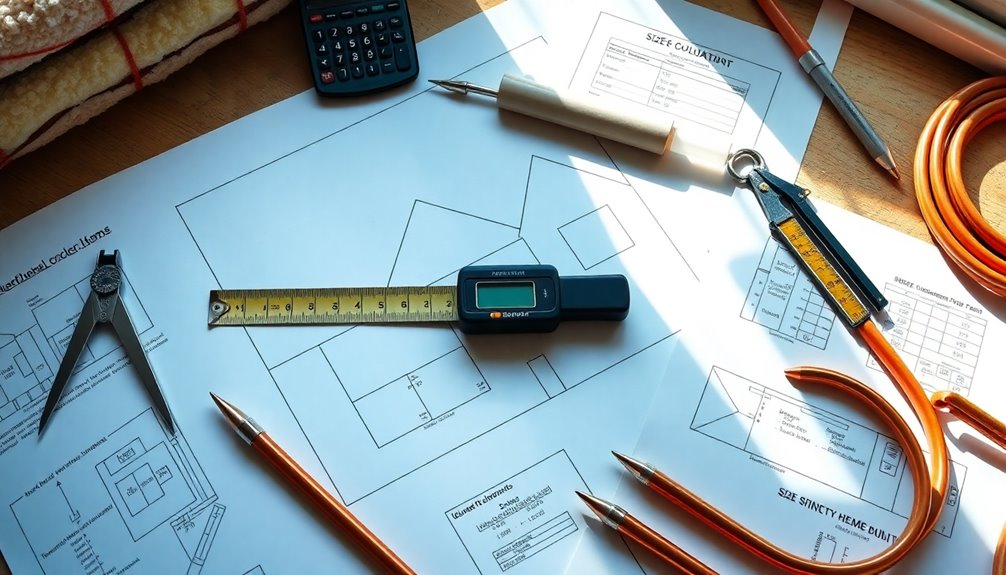
When sizing your heat pump, it's important to start with accurate heat loss calculations for your home.
You'll typically estimate between 16 to 23 BTUs per square foot per hour, depending on your home's dimensions and insulation quality. For instance, a 1,900 square foot house in Maine would have a peak heat loss of about 38,000 BTUs/h, which means you'd need a 3-ton heat pump to meet that demand. Utilizing tools like price comparison sites can help you find competitive pricing for the heat pump that suits your needs. Additionally, exploring comprehensive product reviews can provide insights on the best models available in the market.
Remember, each ton of heat pump capacity is equivalent to 12,000 BTUs/h, so it's necessary to align the heating demand with the nominal ratings provided by manufacturers.
When sizing your heat pump, consider that not all ground source heat pumps will produce the same output from the same input.
Variations in heating capacity and efficiency can impact performance. Accurate sizing is significant; an undersized unit will struggle to maintain comfort, while an oversized one can lead to inefficiencies and higher operating costs. Additionally, using price comparison tools can help you find the best deals on heat pumps to ensure you stay within budget.
Installation Requirements Overview
Successful installation of a DIY geothermal heat pump hinges on several key requirements that secure peak performance. First, you'll need to conduct a thorough heat loss/gain calculation, typically using the ACCA Manual J. This helps determine the appropriate heat pump size based on your home's BTU requirements. For geothermal heating and cooling to work effectively, accurate sizing is vital.
Here are essential requirements to keep in mind:
- Buried Piping: A 5-ton system typically requires about 3,600 feet of buried piping, which consists of six 600-foot coils of 3/4 HDPE pipe for ideal heat exchange.
- Trenching: You'll often need to dig trenches 4-6 feet deep for horizontal loops. This can be done with an excavator or DIY if you have enough space.
- Ductwork Installation: Proper ductwork is important and can exceed $3,000. Make sure it's sealed and sized correctly to make certain your system operates efficiently.
Excavating for Horizontal Loops
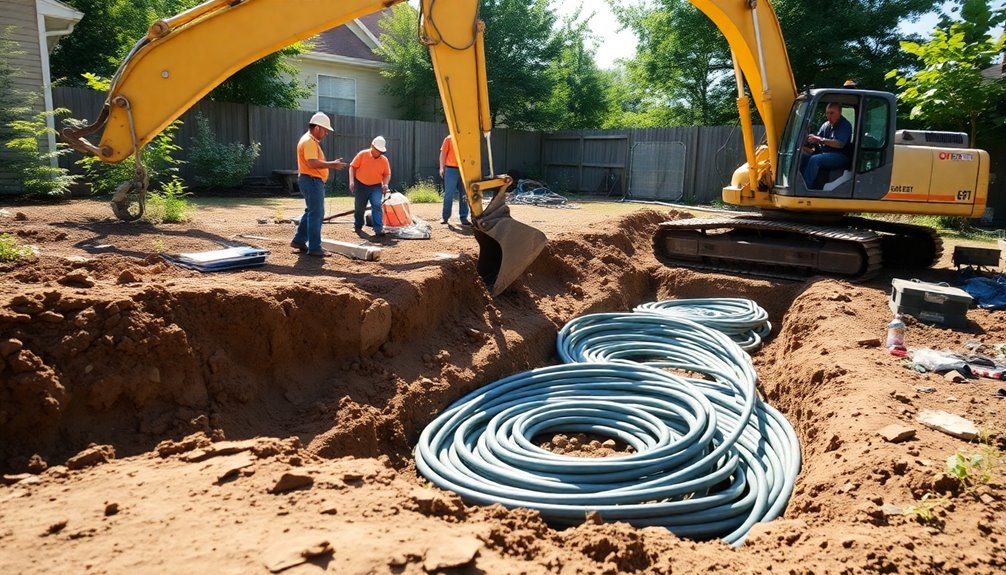
Before you start excavating for horizontal loops, it's important to understand the specific requirements of your geothermal system. Typically, you'll need to dig trenches that are 4 to 6 feet deep to accommodate the piping. A popular choice is the slinky loop design, which coils the pipes to minimize trench lengths, making it easier to fit within your available space.
For a 5-ton heat pump, you'll usually need six 600-foot coils of 3/4 inch HDPE pipe, totaling 3,600 feet of piping. This amount guarantees sufficient heat exchange to keep your system efficient.
While you might consider handling the digging yourself, it's often more practical to hire professional excavation services, which typically average around $1,000, depending on local rates and site conditions.
During the excavation process, pay careful attention to the layout and depth of your trenches. Properly excavating the horizontal ground is vital, as it sets the foundation for effective thermal transfer.
Burying the Geothermal Pipe
Burying your geothermal pipe is an important step in guaranteeing efficient heat exchange. You'll want to dig trenches that are 4-6 feet deep to allow for ideal thermal transfer from the ground.
For a 5-ton heat pump, you'll need six 600-foot coils of piping, totaling 3,600 feet. This can seem intimidating, but using cost-effective trench digging methods is preferred over expensive vertical shafts. Professional excavation services can cost around $1,000, so consider doing it yourself if possible.
Once you've laid the pipe, backfilling the trenches is essential. Proper backfilling guarantees that the pipes are well-covered, which is critical for effective ground-source heat exchange.
Keep in mind the local geothermal properties; they should dictate the depth and layout of the trenches for maximum efficiency.
Here are a few key points to remember:
- Guarantee trenches are 4-6 feet deep for proper heat transfer.
- Use six 600-foot coils for a 5-ton heat pump.
- Backfill immediately after installing the pipes to maintain efficiency.
Constructing the DIY Manifold
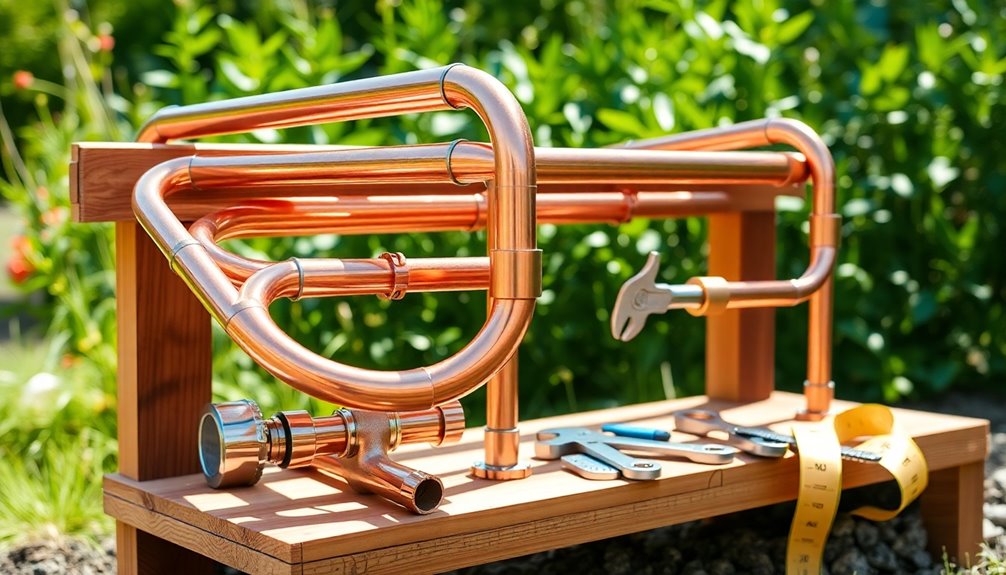
Creating a DIY manifold for your geothermal heat pump system is a significant step in ensuring efficient fluid circulation. Start by gathering 1 1/4 inch PVC fittings, as they provide effective flow control while being cost-effective compared to pre-manufactured options.
However, instead of PEX fittings, opt for galvanized steel fittings, which have proven to be more reliable and help avoid initial leakage issues.
Once you've gathered your materials, assemble the manifold according to proper installation guides. These guides are essential for ensuring that your closed-loop systems operate effectively.
Remember to implement double hose clamps on all connections to secure the fittings and further prevent leaks, which can hamper your system's performance.
If you're looking to enhance fluid circulation, consider integrating a QT Flow Center, which features two pumps and is available for about $699 from Geo-Hydro Supply.
This component is important for maintaining effective fluid flow in your geothermal setup. By carefully constructing your manifold and following these guidelines, you'll set a solid foundation for your geothermal heat pump system, leading to improved efficiency and longevity.
Setting Up the Circulation System
A well-designed circulation system is vital for maximizing the efficiency of your DIY geothermal heat pump. To effectively circulate the fluid between the ground loop and the geothermal unit, consider investing in a QT Flow Center. This system typically features two pumps and costs around $699 from Geo-Hydro Supply.
Additionally, constructing a DIY manifold using 1 1/4 PVC fittings is important for flow control. For durability and leak prevention, you might want to use galvanized steel fittings instead.
Here are some key points to remember:
- Use double hose clamps to secure all connections.
- Verify your circulation system operates on a reliable 12v power supply.
- Follow proper installation guides to maintain peak performance.
Installing the Heat Pump
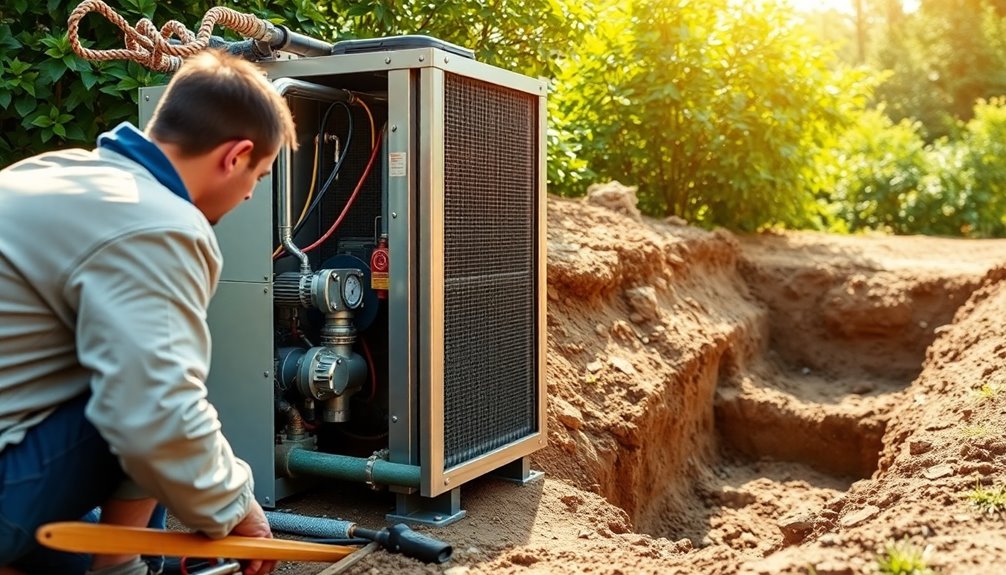
When it comes to installing your DIY geothermal heat pump, choosing the right unit is critical for efficiency and effectiveness. You'll typically want a unit with a capacity ranging from 2 to 5 tons, which corresponds to your home's heating demand calculated in BTUs or kW. For instance, a 5-ton geothermal heat pump produces 48,000 BTUs or 14 kW, so accurate heat loss calculations are imperative.
Next, you'll need to construct a geothermal manifold using 1 1/4 PVC fittings for ideal flow control. Secure all connections with double hose clamps to prevent leaks.
Once your manifold is in place, connect the heat pump to your circulation system, often incorporating a QT Flow Center with two pumps to guarantee efficient fluid circulation.
Don't forget that regular maintenance checks post-installation are essential for ideal performance. Indoor components of geothermal systems can last up to 25 years, so keeping everything in good condition will maximize your investment in ground heating.
Ductwork Considerations
When you're setting up your geothermal heat pump, ductwork plays an essential role in its efficiency.
You need to guarantee proper duct sizing, seal any leaks, and strategize airflow distribution for peak performance.
Getting these elements right can save you money on energy costs and improve your system's effectiveness.
Duct Sizing Importance
Proper duct sizing plays an essential role in the overall efficiency of your geothermal heat pump system. If your ducts aren't sized correctly, you could face air distribution issues that lead to uneven heating and cooling in your home. This not only affects comfort but can also increase energy consumption due to inefficient heat transfer.
To guarantee effective duct sizing, keep these key points in mind:
- Follow the standard rule of 400 CFM per ton of heat pump capacity (a 3-ton system needs about 1200 CFM).
- Use the ACCA Manual D for guidelines and conduct room-by-room heat loss calculations from the ACCA Manual J to determine precise airflow needs.
- Design your ductwork to minimize pressure drops and friction losses, which greatly impact system efficiency.
Proper duct sizing is vital for maintaining your system's performance and longevity. When done right, you'll enjoy ideal comfort and lower energy bills.
Don't overlook this step; it's foundational to your DIY geothermal heat pump project. Investing time in correct duct sizing will pay off in the long run.
Sealing Duct Leaks
Even with precise duct sizing, leaks in your ductwork can undermine the efficiency of your geothermal heat pump system. Properly sealing duct seams is vital, as unsealed ducts can lead to significant energy losses and increased heating costs.
By focusing on sealing duct leaks, you can enhance your system's performance and guarantee you're getting the most out of your investment.
To seal your ductwork effectively, consider using mastic sealant or metal tape. Both provide a durable and reliable barrier against air leaks. In fact, sealing your ducts can improve overall system efficiency by up to 30%, which translates to lower energy bills and a more comfortable home.
Regular inspections of your ductwork are important for identifying leaks. A simple test using smoke pencils or incense can help you pinpoint areas where air escapes.
Don't forget to verify that your ducts are adequately insulated, especially in unconditioned spaces, to prevent heat loss and maintain peak performance.
If you're uncertain about sealing duct leaks yourself, consulting with an HVAC contractor can provide expert guidance and assistance.
Taking these steps will make a noticeable difference in your geothermal system's efficiency.
Airflow Distribution Strategies
Effective airflow distribution is vital for maximizing the efficiency of your geothermal heat pump system. Proper duct sizing is essential; the ACCA Manual D recommends 400 CFM per ton of cooling.
For instance, if you've got a 3-ton unit, you'll need 1200 CFM for effective airflow distribution. To achieve this, conduct room-by-room heat loss calculations using the ACCA Manual J. This guarantees you provide the right airflow for each space, promoting even heating and comfort throughout your home.
Here are some key considerations for ductwork:
- Seal duct seams to prevent energy loss, as leaks can greatly increase operational costs.
- Plan ductwork installation carefully to avoid costly surprises; hiring a contractor can easily cost over $3,000.
- Monitor the ECM blower's performance; incorrect duct sizing can lead to speed hunting, causing noise and inefficiencies.
Domestic Hot Water Solutions
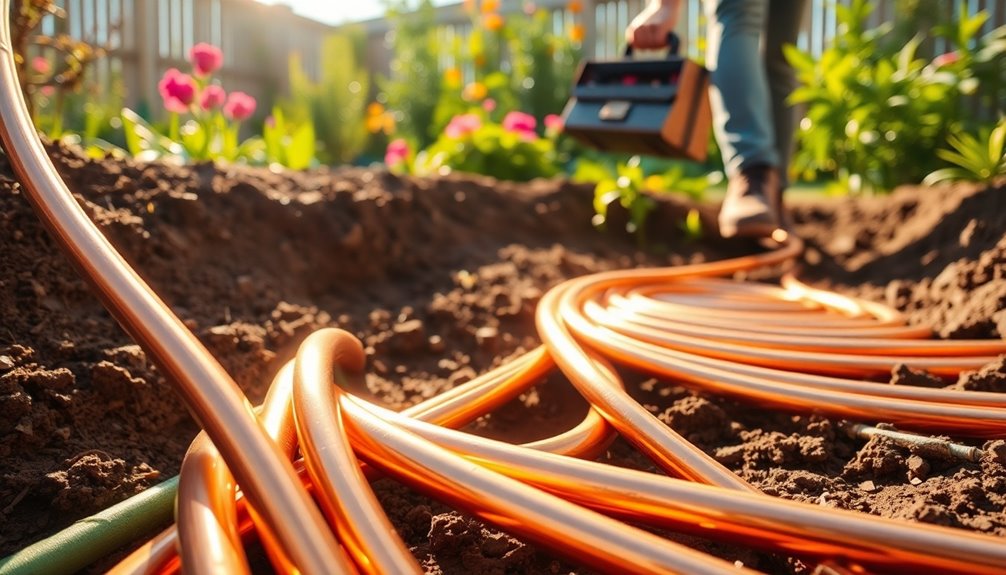
When considering energy-efficient options for your home, integrating a geothermal heat pump system can be a game changer for domestic hot water solutions.
One of the standout features of these systems is the desuperheater option, which can boost your hot water temperature by 10-20 degrees, greatly enhancing overall energy efficiency.
Warm water from the geothermal system is directed to on-demand water heaters, allowing for quick heating and reducing your energy costs.
This setup means you won't have to rely solely on traditional water heating methods, which can be more costly and less efficient.
Using PEX tubing to connect the heat pump to the water tank guarantees efficient heat transfer during operation, making the most of the geothermal energy available.
Not only does a geothermal heat pump provide energy for space heating and cooling, but it also covers your domestic hot water needs, making it a versatile solution for any home.
Tax Credits and Incentives
Installing a geothermal heat pump not only enhances your home's energy efficiency but can also lead to significant financial benefits through various tax credits and incentives.
One of the most appealing options is the federal tax credit, which offers a substantial 30% off the installation costs of geothermal systems. There's no cap on eligible expenses, making this a fantastic way to reduce your upfront costs.
To qualify for these tax benefits, your installation must meet Energy Star requirements, ensuring peak efficiency. Filing for the credit is straightforward; you'll use the Renewable Energy Credits subsection on your tax forms, making the process easier for you.
Here are a few more things to take into account:
- Keep records of your purchases and installations, even though proof isn't needed for tax claims.
- Check for additional state and local incentives that could further enhance your savings.
- Understand that these tax benefits apply to both heating and cooling systems, maximizing the value of your investment in ground heating.
Cost Comparison and Savings
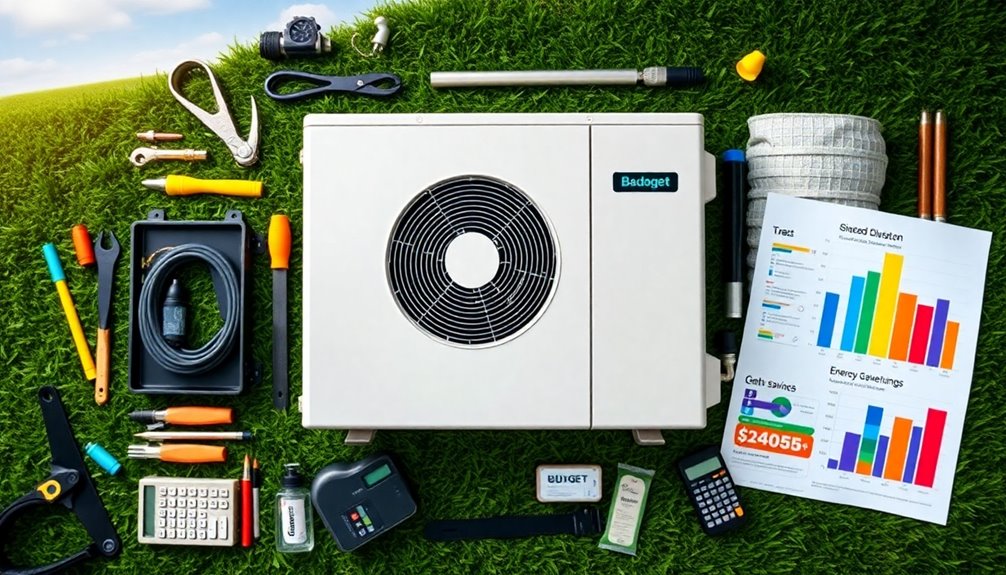
With geothermal heat pumps, you're not just investing in energy efficiency; you're making a smart financial choice that brings significant savings over time. The initial cost of a geothermal system is around $11,000, but after the 30% federal tax credit, you can reduce that to about $7,500.
When you compare this to traditional heating methods, the savings become clear. Monthly bills for heating and cooling can drop to under $100, while propane users often face bills over $400.
The return on investment (ROI) for DIY geothermal systems is impressive. Many homeowners find that their systems pay for themselves within a few years, thanks to long-term energy bill savings. You could save anywhere from 30% to 70% on heating costs and 20% to 50% on cooling costs.
The systems operate efficiently, producing 3.5 to 5 times the energy they consume, translating to a high Coefficient of Performance (COP). Keep in mind that local utility rates and the specific COP ratings of your heat pump will heavily influence your overall savings.
In short, a geothermal system is a financially savvy choice that offers substantial savings and a strong cost comparison to traditional heating methods.
Conclusion
Incorporating a DIY geothermal heat pump isn't just a project; it's like planting a seed for sustainable living, blooming into energy savings and comfort. By harnessing the earth's constant temperature, you're not only reducing your carbon footprint but also revealing long-term financial benefits. Imagine cozy winters and cool summers, all while contributing to a greener planet. Take the plunge, and turn your home into an eco-friendly haven that thrives on nature's gifts. Your energy revolution starts now!



